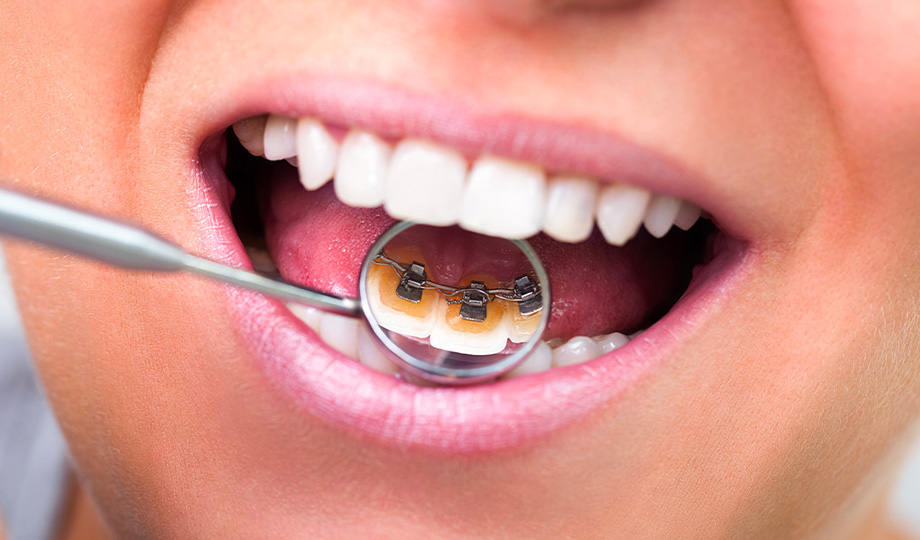Lingual braces are an esthetic option for patients who don’t want to wear traditional braces or when Invisalign® and clear aligners are not an option. These unique braces are created using state-of-the-art technology and are 100% customized to the shape of your teeth. Lingual braces have the unique prescription that Dr. Woolfson and Dr. Dubiner create for you, built-in to ensure you get the results that you want. With lingual braces, you get efficient tooth movement with great esthetics.
Advantages to lingual braces include:
- Complete discretion – they are placed behind your teeth, so no one even has to know you’re in braces
- Highly accurate treatment results because they are created just for you
- Avoid injury to your lips or mouth due to sports or an accident

What are lingual braces?
Lingual braces are metal braces, but with a big twist. Rather than being visible to the entire world, lingual braces are placed on the lingual, or tongue, side of the teeth. That means no one will even know you have braces because they are completely hidden.
Are lingual braces effective?
Your orthodontist designed your lingual braces just for you, down to the exact placement of the brackets. Using 3D guided robotics, lingual braces can produce highly accurate treatment results.
Are there disadvantages to lingual braces?
When it comes to orthodontic treatment, there are always some adjustments to be made while you are getting used to everything. Wearing lingual braces is no different. Because of their placement, it can take a bit of time to get used to having the braces in your mouth. Your speech may be impeded a bit in the beginning as your tongue is getting used to the brackets and wires. You will also have to pay close attention to your oral care routine – since the brackets and wires are behind your teeth, the extra focus will be needed to make sure you’ve cleaned your teeth thoroughly.
Are lingual braces right for me?
Lingual braces are an excellent tooth straightening option for many patients. To determine if you may benefit from lingual braces, schedule a consultation at our office Dr. Dubiner and Dr. Woolfson can explain the benefits of lingual braces and determine if they may be the right option for you.
FAQ
How do lingual braces work?
Lingual braces follow the same principles as traditional metal braces. The brackets still go on each tooth, and they are all linked by an archwire. The main difference is that these brackets and wires all go on the lingual surface of your teeth, meaning they sit at the back of your teeth and remain hidden from prying eyes. All in all, lingual braces work just as regular braces do.
What not to eat with lingual braces?
Please avoid hard foods that could accidentally loosen a bracket or dislodge a wire. Likewise, you should stay away from sticky foods. Dietary recommendations about what you can eat with lingual braces are similar to the ones patients have to follow with traditional appliances. The goal is to avoid orthodontic emergencies and promote good oral hygiene.
What to expect with lingual braces?
The main advantage patients should consider is that they won’t have to worry about any unwanted attention or odd looks when they smile. No one will get to see your braces when you smile or talk. Lingual braces offer the same level of care as traditional appliances, but you will have to be more careful about keeping good oral hygiene. Considering each bracket will remain “hidden” behind your teeth, you’ll have to be more attentive to your brushing and flossing habits.
How long do you keep lingual braces on?
Please keep in mind that treatment length varies from one case to another. No two patients may spend exactly the same time with their braces on. Even when several patients use the same appliance, their unique circumstances, personal goals, and orthodontic problem complexity will make the overall treatment length vary considerably. Please consult with our orthodontist to learn more about the estimated time you’ll spend with braces.
How do I clean my lingual braces?
With much care. Please remember to select a soft-bristled toothbrush and use circular motions while you go around each bracket very carefully. You should also remember to brush your teeth after every meal you eat to avoid the unwanted accumulation of food debris that promotes the multiplication of harmful bacteria, plaque, and tartar.
What to expect during the first visit?
Your first visit to your orthodontist in Yulee, FL, is going to be a great experience. We’re just going to review your medical history, gather some data on what your orthodontic problems are, and create a patient history with sufficient evidence of the current state of your dental structures. We might need a few x-ray images and pictures. Don’t worry; this first visit to the orthodontist won’t take too long, and you’ll leave the office with a pretty clear idea of what treatment you require.



